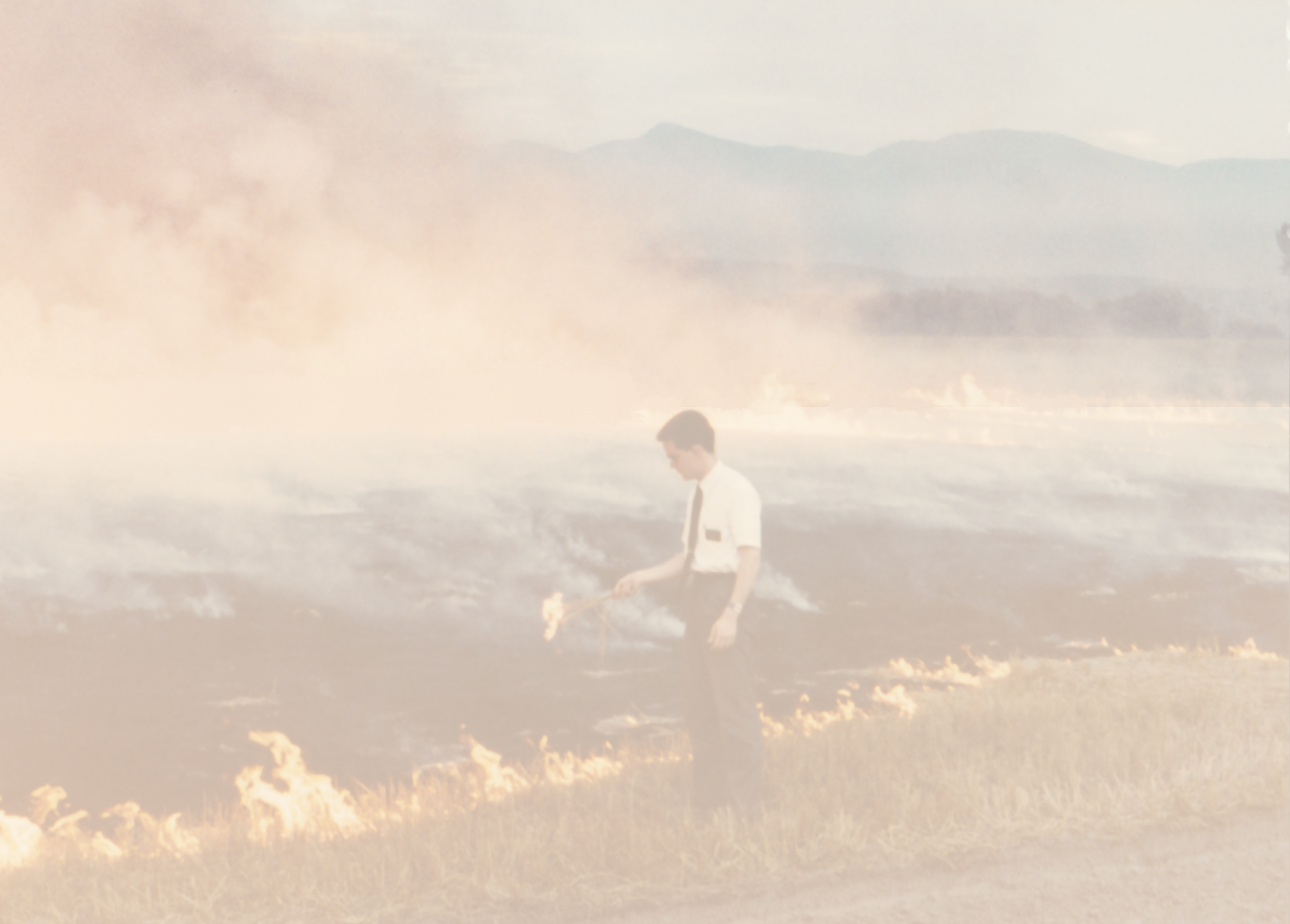For the remainder of the hour, Elder Fowler and I wound Buddy Van Rijk in an increasingly constrictive net of dogma, woven from strands—even by Christian standards—of ever more tenuous logic. It was the type of snare that can only constrain a willing captive; one misstatement on our part, one question or concern unsatisfactorily addressed, and the whole careful construct falls away like trick ropes from an escape artist.
Elder Fowler explained the role Jesus Christ plays in the Plan of Salvation, negating through His sacrifice the effects of death and sin that would otherwise prevent us from returning to God's presence. (Being a sports fan, Van Rijk was surely familiar with the supporting New Testament verse—John 3:16, "For God so loved the world, that he gave his only begotten Son"—that Fowler asked him to read aloud from the family Bible.) I described the process by which God makes the Plan known to His children: instructing prophets to pass His words along to all the Earth's inhabitants, which come to us as scripture. Relating an abbreviated version of Joseph Smith's First Vision as anecdotal evidence, Elder Fowler affirmed that God continues to speak to prophets in our modern day and age. Then I put forth the Book of Mormon as one of the premier fruits of Joseph's holy calling, and briefly summarized its premise and contents.
In these latter parts of the discussion, we painted Joseph Smith for our investigator the way weak sunlight paints a stained-glass saint for the parishioners inside a cathedral—we rendered him beatific and blessèd, aglow with a numinous radiance, yet for all that curiously flat, distant, and inscrutable. We applied no brushstroke that might have brought life to that colorful rogue, teased out no overlooked detail that might have shed light on his enormous charisma (a force so powerful that Mormons still love the man fiercely and recklessly more than a century and a half after his death). In our singleminded quest to prove both Joseph and his magnum opus modern witnesses of Christ, we certainly recounted no tale like the one I'm about to tell. But stories like these are as great a part of the appeal of Mormonism as the doctrine of eternal families—to long-standing members, perhaps even more so. Check this out:
It was probably late in 1812 that typhoid fever swept through Joseph Smith's family. The previous year his parents had settled with their six living children in Lebanon, New Hampshire, where, after a series of financial disasters, they had begun at last to regain their footing. Joseph would have been nearly seven when he and his siblings, including the new baby Catherine, took sick. All seven children eventually recovered, though Joseph's older sister Sophronia nearly died and Joseph himself developed a painful abscess (what he called a "fever sore") in one shoulder.
After first misdiagnosing the complaint as a sprain, a local doctor lanced the abscess. This temporarily relieved young Joseph's discomfort, but also admitted the bacterial infection to his bloodstream. The disease soon moved to Joseph's lower left leg, where typhoid osteomyelitis inflamed his tibia. For weeks Joseph suffered unrelenting agony; his only two respites came when the doctor returned to drain the resulting abscess, laying open the flesh of the leg all the way to the bone. But the bone itself was diseased, and the pain returned all too quickly.
Early in 1813, as best historians can reconstruct the date, a council of surgeons (somewhere between seven and eleven in number) determined that Joseph would die unless his leg was removed. Joseph's mother Lucy, weary after weeks and weeks of caring for her sick son, nonetheless refused to give permission for an amputation, demanding that the surgeons to make one more attempt to root out the infection. As the chief surgical consultant, Nathan Smith (no relation to Joseph), had pioneered a difficult technique for removing necrotic bone in 1798, the surgeons relented and reentered Joseph's sickroom to prepare the boy for that very operation.
When they announced their intentions, Joseph's overwrought father burst out sobbing at the side of the bed. Joseph himself remained relatively calm, agreeing to the operation but refusing to allow the surgeons to tie him to the bed. By Lucy's account, Joseph told them, "I can bear the process better unconfined."
The surgeons then insisted that he drink some brandy to dull the pain, but Joseph refused that too, and wine when it was offered instead. "I will not touch one particle of liquor," he said; "neither will I be tied down: but I will tell you what I will do, I will have my Father sit on the bed close by me; and then I will do whatever is necessary to be done, in order to have the bone taken out."
Joseph, knowing she could not bear to witness his suffering, told his mother to leave the room. After bringing fresh linen to place under his leg, she removed herself to a full hundred yards from the house. The operation commenced.
The surgeons opened Joseph's leg with a crude scalpel that was likely a full terrifying foot in length. They bored holes on both sides of the infected area of the tibia, then used forceps to break off pieces of the dead bone between. Twice Joseph's screams drew his frantic mother back into the room. The first time Joseph cried that he could tough it out if only she would leave. The second time, confronted by the sight of Joseph's pale, sweat-drenched face and the seeming gallons of blood that covered the sheets and no doubt the surgeons too, Lucy had to be, in her own words, "forced from the room and detained."
Fourteen pieces of bone were eventually broken from Joseph's tibia, and, miraculous to relate, he recovered from the operation almost fully, retaining only a slight limp in adulthood. (It is not known what injuries may have been sustained by the surgeons at the hands of Joseph's mother during the operation.)
Can you see the stern stuff of which our Prophet was made? Can you see the mettle? With integrity and courage like that, is it any wonder Joseph would not just master his disease but grow to become the greatest religious leader of his time? Is it any wonder we Saints still love him so unreservedly?
Is it any wonder we don't tell this story to the faint of heart?
#A note:
When I say "faint of heart," I'm only talking about investigators. Mormons have no compunction about telling this inspiring story to their children (the focus, of course, being that Joseph wouldn't touch liquor even when it was the only anesthetic available). I must have heard this story a dozen times before I was Joseph's age, and every time the spectacle thrilled and horrified me to my core. I tried unsuccessfully to imagine what I would have done in his place (today I'm sure the answer is cry, throw up, and pass out), and I grew to idolize the child who would face such agony for the Word of Wisdom's sake.
Of course, the Word of Wisdom wouldn't make its debut for another twenty years, and when you consider his later casual enjoyment of beer and wine it pretty much puts the lie to this image of Joseph as a steadfast teetotaler, and thus to the moral of the story. But there's no reason to doubt the truthfulness of this episode, which both Joseph and his mother recorded and which is circumstantially corroborated by Nathan Smith's descriptions of the surgical technique involved. So how do we explain it?
In his book Inside the Mind of Joseph Smith, psychiatrist Robert D. Anderson argues—persuasively, I might add—that the dysfunction of Joseph's parents had induced what child psychologists call a "reversal of generations." Anderson, noting that Joseph's father unhelpfully sobbed like a baby at a moment of crisis and need, says:
Mormon writers have used this story to suggest how good this future prophet was even as a child, and how much his parents cared. In therapeutic terms, this incident is not a commendable one. Joseph was a young child, possibly five, no more than seven, desperately protecting the emotional state of his parents even while he was undergoing a life-threatening crisis and extreme physical pain. The implication is that they were unstable and that, even at this early age, he has learned that his security depends on providing security for them.
And why did Joseph refuse the brandy? Writes Anderson, after careful groundwork: "I would suggest that [Joseph Sr.] had drunk to excess on at least enough occasions by this point that it had become a source of conflict between Lucy and [him]. Where else but in family arguments would seven-year-old Joseph have learned to avoid alcohol, even as an emergency medication, so adamantly?"
Viewed in this light, Joseph's life story, motivated by an alcoholic father and a depressive mother (another conclusion for which Anderson lays a painstaking foundation), becomes far more tragic and heart-breaking than heroic. In fact, the surgeon's bloody scalpel becomes the controlling image in Joseph's development, appearing in the Book of Mormon time and again in the guise of a great sword, impelling his rise to ever greater religious conquests, and even transforming adult horseplay into revenge on the surgeons who so brutally hacked apart his leg. (Twice as a grown man Joseph broke the legs of wrestling opponents significantly smaller than he.)
That's as may be. Well do I know, after having written a novel in which every major character must work through issues with his father, how easily subconscious symbols can slip into a writer's output. But as the pathology of dysfunctional family interactions has no place in this book, let me return you without further ado to the discussion at the Van Rijk home, already in progress.





